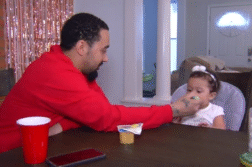SALT LAKE CITY, Utah (Ivanhoe Newswire) – Breast cancer — more than three hundred thousand people in the US will be diagnosed with it this year and it’s not just a disease that impacts women. Almost 2,800 men will be told they have it. And for men, the diagnosis is commonly made after the cancer has spread — that means curing it is even harder, if not impossible. But now, one man is adapting a theory from farmers to change how men and women with breast cancer are treated. Male breast cancer
Neurobiologist Christopher Gregg at Huntsman Cancer Institute and the University of Utah has dedicated his life to studying human genetics — but little did he know he would become his own lab-rat.
Professor Gregg, PhD, says, “As somebody who does run a lab with many lab mice, the irony has not been lost on me.”
Professor Gregg was diagnosed with breast cancer. He says, “I woke up one morning and my nipple was bleeding.”
After a mastectomy he was told the cancer was gone. Then eight years later an MRI revealed a large tumor on his hip and spine.
“I knew that a stage four diagnosis with metastatic disease and different sites was a terminal diagnosis. I knew right away,” says Professor Gregg.
Professor Gregg gathered the top experts in the field and found new ideas that would change the course of his treatment. Those ideas were based on how farmers protect their fields from pests.
Professor Gregg explains, “You rotate the chemical classes of the pesticides. So, you’re never chronically spraying with the same chemical until everybody develops resistant.”
Saundra Buys, MD, Oncologist at Huntsman Cancer Institute, University of Utah says, “So he brought these crazy ideas to me and they made sense.”
In 2018 Professor Gregg started extinction therapy — rotating already approved FDA medications before his cancer developed resistance …
“The key is that I never progressed or became resistant to 11 different drugs over all of those years” says Professor Gregg.
Doctor Buys says, “He’s doing better now than I would expect for somebody who’s out as far as he is.”
Professor Gregg’s team created an algorithm using AI to accurately measure a patient’s symptoms.
Professor Gregg says, “We don’t need another billion-dollar drug that costs a patient 20 to $30,000 a month to treat their cancer. The dream is a very cheap algorithm that works through your smartphone and tells you exactly when and what to take and how much.”
Turning a lethal cancer into a manageable chronic disease.
Professor Gregg and his team will continue to develop the tool, using it in a clinical trial at the Moffitt Cancer Center starting later this year, as well as other clinical trials beginning at Emory University and the Huntsman Cancer Center. He hopes to make extinction therapy available to metastatic cancer patients in the next three years.
Contributors to this news report include: Marsha Lewis, Producer; Matt Goldschmidt, Videographer; Roque Correa, Editor.
To receive a free weekly e-mail on medical breakthroughs from Ivanhoe, sign up at: http://www.ivanhoe.com/ftk
Source:
https://www.cancer.org/cancer/types/breast-cancer/about/how-common-is-breast-cancer.html
MEDICAL BREAKTHROUGHS
RESEARCH SUMMARY
TITLE: A FIRST FOR TREATING MALE BREAST CANCER: EXTINCTION THERAPY
REPORT: MB #5398
BACKGROUND: Male breast cancer is a type of cancer that grows in the breast tissue in your chest. Although men and people assigned male at birth (AMAB) don’t have breasts that produce milk, they have fatty tissue, ducts and breast cells that can become cancerous. Cancer develops when cells in these tissues grow uncontrollably, forming a tumor. Male breast cancer is extremely rare as only about 2,800 people AMAB in the United States receive this diagnosis annually. This is less than 1% of total breast cancer cases among either sex. Breast cancer may occur in men at any age, but it usually occurs in men between 60 and 70 years of age. Men with breast cancer usually have lumps that can be felt.
(Sources: https://my.clevelandclinic.org/health/diseases/9011-male-breast-cancer, https://www.cancer.gov/types/breast/patient/male-breast-treatment-pdq)
DIAGNOSING: Tests are used to help doctors diagnose breast conditions: diagnostic mammogram, breast ultrasound, and breast biopsy. Breast ultrasound, sound waves are used to create a computer image of the inside of the breast. A gel is applied to the skin of the breast, and a wand-like instrument called a transducer is passed over the skin. The most common type of biopsy used to diagnose breast cancer is core needle biopsy (CNB). In this procedure, a wide, hollow needle is used to remove pieces of breast tissue from a suspicious area. The needle used in this technique is larger than that used for fine needle aspiration (FNA), allowing the doctor to remove larger cylinders (cores) of tissue. Typically, several cylinders are removed.
TREATMENT: Dr. Christopher Gregg has identified new ways to help with metastatic cancer. After discovering a promising study, he invited researchers to a symposium at Huntsman Cancer Institute. During the symposium, they collaborated on Gregg’s first treatment plan: extinction therapy. Extinction therapy involves introducing new medication before the cancer develops resistance, targeting the disease before it progresses. Gregg refers to this as a treatment resistance management plan and believes that it will become a standard practice, improving metastatic cancer care. Since his breast cancer diagnosis in 2018, he and his oncologist have effectively managed treatment resistance in his care. They continue to work on preventing the development of resistance.
FOR MORE INFORMATION ON THIS REPORT, PLEASE CONTACT:
Steve Lee
If this story or any other Ivanhoe story has impacted your life or prompted you or someone you know to seek or change treatments, please let us know by contacting Marjorie Bekaert Thomas at mthomas@ivanhoe.com




